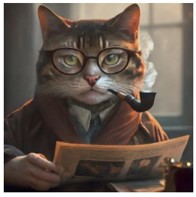Bespectacled Cats: An Update on AI + Copyright
Join our email list today to receive alerts, articles, invitations to events and more!
4 min read
Overview
Canada’s copyright law requires human authorship for a work to qualify for protection, meaning purely AI-generated content does not benefit from copyright. A pending Federal Court case may test whether AI can be recognized as a co-author alongside a human. While Canada’s current legal framework aligns closely with U.S. standards, its handling of this case could set new precedent. Unlike the UK, which allows copyright for computer-generated works under specific rules, Canada remains firmly grounded in the principle that only human creativity qualifies for protection. As more organizations adopt generative AI, the Canadian courts, rather than legislators, are expected to play a key role in shaping how copyright law adapts to AI technologies.
Can generative AI create copyright-protected works?1
Prompt | Output |
professional photo, bespectacled cat in a robe reading the Sunday newspaper and smoking a pipe, foggy, wet, stormy, 70mm, cinematic, highly detailed wood, cinematic lighting, intricate, sharp focus, medium shot, (centered image composition), (professionally color graded), ((bright soft diffused light)), volumetric fog, hdr 4k, 8k, realistic GEMINI (last visited Jan. 17, 2025) |  |
professional photo, bespectacled cat in a robe reading the Sunday newspaper and smoking a pipe, foggy, wet, stormy, 70mm, cinematic, highly detailed wood, cinematic lighting, intricate, sharp focus, medium shot, (centered image composition), (professionally color graded), ((bright soft diffused light)), volumetric fog, hdr 4k, 8k, realistic ChatGPT (May 26, 2025) |  |
Although the prompt is identical, the images are obviously different, and unique. Who owns copyright in the images? The person who wrote the prompt? The person inputting the prompt? The companies that offer Gemini and ChatGPT? No-one?
Copyright in the U.S.
In March 2023, the U.S. Copyright Office issued guidance to clarify copyright eligibility for works containing material created with GenAI tools. This guidance states, "If a work’s traditional elements of authorship were produced by a machine, the work lacks human authorship and the Office will not register it." Nevertheless, "work containing AI-generated material along with sufficient human authorship might be eligible for copyright protection."
In short, for copyright to apply to AI-generated works, the human authorship requirement must be met.
The U.S. Copyright Office recently released Copyright and Artificial Intelligence, Part 2 Copyrightability Report which reiterates the 2023 guidance with more nuance and background discussion.
Prior US decisions – one involving a photograph taken by a monkey, and one involving messages from "divine beings" – have confirmed the basic tenet of U.S. copyright law, that copyright protection requires human authorship. The work will be copyrightable only to the extent that human contributions qualify as authorship.
A prompt is, in many ways, similar to an instruction to an artist to create an illustration, since it's left to the artist – or in the case of AI, the generative tool- to decide how to interpret the prompt to generate the output. As the Copyright Office put it: " …prompts alone do not provide sufficient human control to make users of an AI system the authors of the output. Prompts essentially function as instructions that convey unprotectible ideas."
This means the AI-related copyright fights of the future will be around the degree of human involvement, whether there is sufficient authorship to qualify for copyright purposes, and which elements are subject to copyright. A number of cases before U.S. courts will help clarify where these lines can be drawn for the purposes of determining copyright when GenAI is involved.
Copyright in the UK
Copyright in Canada and the U.S. evolved from British roots, but interestingly, the Copyright, Designs and Patents Act (CDPA) in the UK has a unique feature that doesn’t have an exact equivalent in Canadian or American copyright law. Section 9(3) of the CDPA provides specific protection for "computer-generated works" (CGWs). This unique form of protection, which dates from the 1980s, applies to literary works, musical and artistic works which are "generated by computer in circumstances such that there is no human author".
In this situation, the author is the person "by whom the arrangements necessary for the creation of the work are undertaken". This seems clear that if generative AI outputs an image or literary content in response to a user prompt, the "author" will be person who inputs the prompt. In Nova Productions Ltd v Mazooma Games Ltd & Ors (CA), [2007] EWCA Civ 219, the court decided that images generated during gameplay were protectable CGWs, and that the developer who wrote the code was the author for the purposes of Section 9 of the CDPA.
While this provision of the CDPA has been criticized, and copyright reform advocates have supported its removal, it remains on the books, and seems to provide an avenue for attribution of copyright protection for AI-generated works in the UK.
Copyright in Canada
In Canada (as in the U.S.), the law is clear that a human author is required to create an original work for copyright purposes: See Geophysical Service Incorporated v Encana Corporation.
This seems clear on its face. However, the mechanics of copyright registration in Canada have permitted the registration of a work in which an AI tool is listed as a co-author for copyright purposes, along with a human co-author. Registration of the image (entitled Suryast) is being challenged by the Samuelson-Glushko Canadian Internet Policy and Public Interest Clinic (CIPPIC). CIPPIC filed a Federal Court application to expunge the registration, or amend it to confirm that the "RAGHAV Artificial Intelligence Painting App" cannot function as an author for copyright purposes in Canada. This case of Samuelson-Glushko Canadian Internet Policy and Public Interest Clinic v. Ankit Sahni (Court File No. T-1717-24-ID) provides an opportunity for the Federal Court to clarify this area of law.
Conclusion
According to current copyright law, there is no copyright attaching to these bespectacled cats since they are entirely the product of GenAI.
There are more than a dozen AI-copyright lawsuits in the works, in both Canada and the US. These are more likely to produce clarity on where the law draws the lines, since AI regulation and legislative reform (when it comes) is likely to be focussed on other issues. While we await guidance from the courts, make sure your organization stays up to date on the latest developments in artificial intelligence and intellectual property.
Navigating the legal grey areas of AI-generated content requires up-to-date guidance on evolving copyright laws. For strategic advice on authorship, ownership, and compliance in the age of generative AI, contact Richard Stobbe or any member of our Intellectual Property or Artificial Intelligence teams.
1 The top image is from Page 19 of Copyright and Artificial Intelligence, Part 2: Copyrightability, published in January 2025 by the United States Copyright Office. The second image was generated in May 2025 by ChatGPT using the identical prompt.

